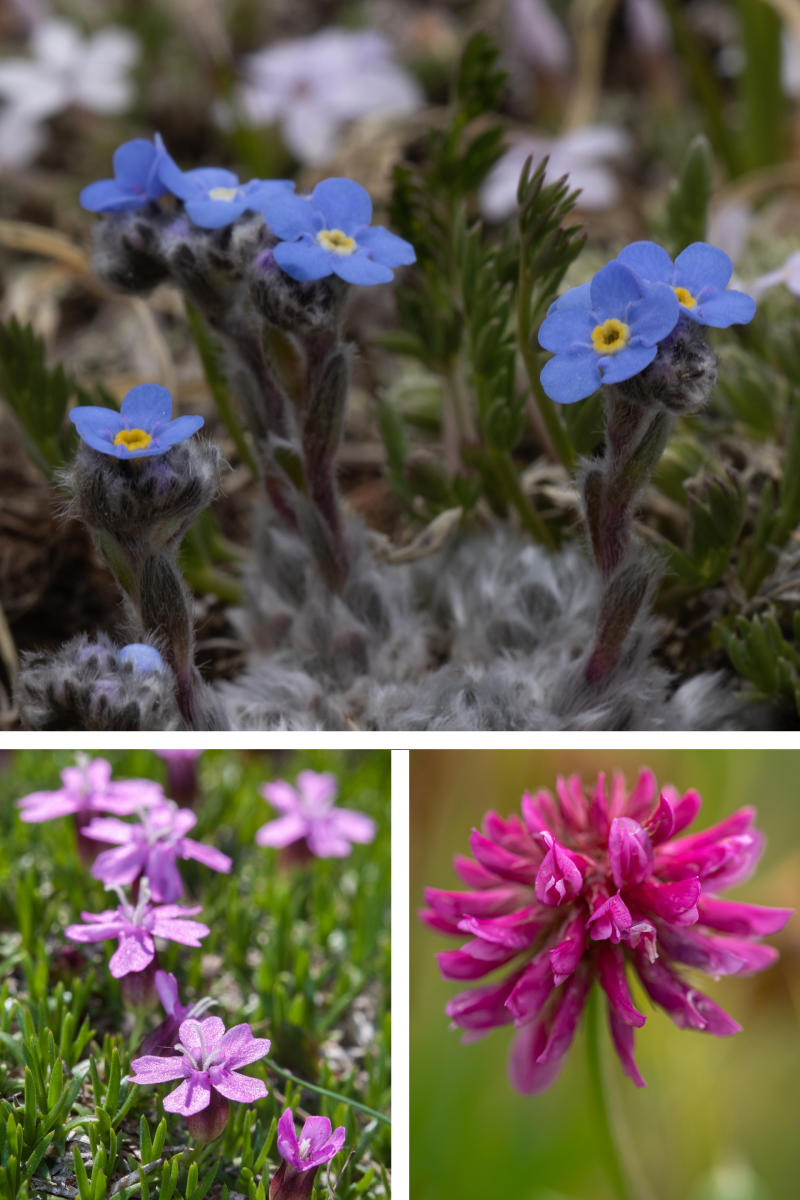THE MOUNTAINS OF NORTHERN NEW MEXICO allow hikers to experience five of New Mexico’s life zones, from foothills to alpine tundra. Each environment has characteristic plant communities that have adapted to conditions at specific elevations. Take these as general guidelines, not strict property boundaries.
Piñon-Juniper Zone (6,000 to 7,500 feet)
 Clockwise from top: Scarlet penstemon (Penstemon barbatus), Chocolate flower (Berlandiera lyrata), and Foothills paintbrush (Castilleja integra). Photographs by Christina Selby.
Clockwise from top: Scarlet penstemon (Penstemon barbatus), Chocolate flower (Berlandiera lyrata), and Foothills paintbrush (Castilleja integra). Photographs by Christina Selby.
Scarlet penstemon (Penstemon barbatus)
To hummingbirds’ delight, this tall stalk loaded with bright red tubular flowers starts blooming in June, just when the birds are migrating north and need a shot of sugary nectar. Red penstemon and hummingbirds have a history of attraction and coevolution over millennia.
Chocolate flower (Berlandiera lyrata)
This night-blooming plant offers its scent in the early morning to attract pollinating hoverflies to its chocolate-flavored stamens. In the heat of the day, the flower droops and the scent recedes.
Foothills paintbrush (Castilleja integra)
The brilliant red structures are a modified leaf with narrow green-yellow tube flowers. This hemiparasitic species gets some of its nutrients from the sun via photosynthesis but also parasitizes the roots of other plants, including grasses and oaks.
Ponderosa pine Zone (7,500 to 8,500 feet)
 Clockwise from top: Skyrocket (Ipomopsis aggregata), Wild bee balm (Monarda fistulosa), and Creeping Oregon grape (Mahonia repens). Photographs by Christina Selby (2) and Shutterstock.
Clockwise from top: Skyrocket (Ipomopsis aggregata), Wild bee balm (Monarda fistulosa), and Creeping Oregon grape (Mahonia repens). Photographs by Christina Selby (2) and Shutterstock.
Skyrocket (Ipomopsis aggregata)
Pollinated mostly by long-tongued moths and hummingbirds, this plant’s red tubular flowers bloom in late spring to early summer—and into fall, if there’s enough moisture. Optimal growing conditions include little water, part shade, and sandy soil. It also creeps into the mixed conifer zone.
Wild bee balm (Monarda fistulosa)
A member of the mint family, this plant has a square stem, which can be felt if rolled (gently!) between your fingers. The foliage’s strong aroma and purple flowers attract bees, butterflies, and hummingbirds. The wild variety is slightly smaller than its horticultural cousin, a favorite in North American gardens.Creeping Oregon grape (Mahonia repens)
This small evergreen plant, one of the first to bloom in the season, is often found in widespread patches where few other plants are growing. The eye-catching yellow flowers turn into blue berries that resemble grapes and are a favorite treat (though quite tart) for wildlife, birds, and intrepid hikers.
Mixed Conifer Zone (7,500 to 9,500 feet)

Clockwise from top: Mountain death camas (Anticlea elegans), Orange sneezeweed (Hymenoxys hoopesii), and Violet woodsorrel (Oxalis violacea). Photographs by Christina Selby.
Mountain death camas (Anticlea elegans)
Don’t let the thin lily leaves and tall stalks of these white flowers fool you. Those kidney-bean-shaped green spots on its petals are a warning: The leaves, roots, flowers, and seeds are all poisonous to livestock and people. A good reminder to admire the beauty of wildflowers and let them be.
Orange sneezeweed (Hymenoxys hoopesii)
Bright yellow petals hang like a skirt from a central orange dome with branched clusters of blossoms making up a single plant. Reportedly, miners stuffed the crushed petals up their noses to clear their sinuses at the end of a day underground.
Violet woodsorrel (Oxalis violacea)
This small, pink bloom rises from three heart-shaped leaves in dry ponderosa and mixed conifer forests. Their sour, lemony flavor is caused by oxalic acid in the leaves and stem, which is delicious for a taste but poisonous in large quantities.
Spruce-Fir Zone (9,000 to 11,500 feet)

Clockwise from top: Coralroot orchids (Corallorhiza maculata), Sidebells wintergreen (Orthilia secunda), and Short Jacob’s ladder (Polemonium pulcherrimum) Photographs by Christina Selby, Michael Stubben/Shutterstock, Christina Selby.
Coralroot orchids (Corallorhiza maculata)
While not as showy as other New Mexico orchids, the large plant clusters, with orange to red stems and multiple spotted or striped white flowers, pop in the evergreen forest. These saprophytic plants lack chlorophyll to make their own food, instead attaching to an underground network of mycorrhizal fungi that draw nutrients from decaying leaf litter and share them with the orchid.
Sidebells wintergreen (Orthilia secunda)
The urn-shaped white flowers lean to one side and the leaves remain green throughout winter, hence the common name. Abundant in our spruce-fir forests, this plant also manages to grow in high altitudes around the world.
Short Jacob’s ladder (Polemonium pulcherrimum)
Where shade prevents an abundance of growth, this plant forms a cheerful skirt of purple blooms around the base of spruce trees. Rain and snow determine the presence of blooms, but when precipitation is plentiful, these brighten even the darkest woods.
Alpine Zone (11,500 feet and above)

Clockwise from top: Alpine forget-me-nots (Eritrichium nanum), Alpine clover (Trifolium attenuatum), and Moss campion (Silene acaulis). Photographs by Christina Selby (2) and Viktor Loki/Shutterstock.
Alpine forget-me-nots (Eritrichium nanum)
With blooms the size of a fingernail, a scent so sweet you will swoon, and an uncommon bright blue color, they will remain forever etched in your memory—as will the long, steep hike required to see them.
Alpine clover (Trifolium attenuatum)
These fragrant, eye-catching pink to purple flowers can be abundant above the tree line. Plants form widely spreading mats several feet in diameter to blanket rocky or gravelly slopes. Penitente Peak seems prone to growing a thick beard of these across its summit.
Moss campion (Silene acaulis)
As delicate as these tiny pink beauties may seem, they are built to withstand freezing mountaintop winds. Growing low and slow, their cushion-like form of tightly packed leaves keeps things cozy inside, where it can be up to 10 degrees warmer than ambient temperatures.


